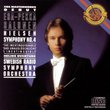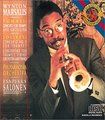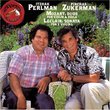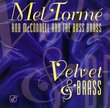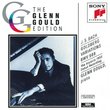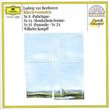| All Artists: Wolfgang Amadeus Mozart, Ludwig van Beethoven, Murray Perahia, Members of English Chamber Orchestra, Anthony Halstead, Graham Sheen, Thea King, Neil Black Title: Mozart/ Beethoven: Quintets for Piano & Winds Members Wishing: 0 Total Copies: 0 Label: Sony Release Date: 10/25/1990 Genre: Classical Styles: Chamber Music, Historical Periods, Classical (c.1770-1830), Modern, 20th, & 21st Century Number of Discs: 1 SwapaCD Credits: 1 UPC: 074644209921 |
Search - Wolfgang Amadeus Mozart, Ludwig van Beethoven, Murray Perahia :: Mozart/ Beethoven: Quintets for Piano & Winds
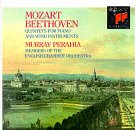 | Wolfgang Amadeus Mozart, Ludwig van Beethoven, Murray Perahia Mozart/ Beethoven: Quintets for Piano & Winds Genre: Classical
|
Larger Image |
CD DetailsSimilar CDs
Similarly Requested CDs
|
CD ReviewsThe Mozart and Beethoven Piano and Wind Quintets Robin Friedman | Washington, D.C. United States | 11/27/2004 (5 out of 5 stars) "I was enchanted with Mozart's Quintet for Piano and Winds, K. 452, when I heard it on a CD featuring Dennis Brain performing the Mozart horn concertos. I wanted to explore this work further and hear it together with Beethoven's Quintet opus 16. I was eager to compare at first-hand two similar compositions, one by Mozart at the height of his powers the other by Beethoven as a rising young musician in Vienna. This CD with pianist Murray Perahia and members of the English Chamber Orchestra is an admirable way to get to know these works and to develop one's ear for music. Mozart's composed his quintet in March, 1784 when he was also writing his famous series of piano concertos. He described it as "the best work I have ever composed". The work is scored for the unusual combination of piano, oboe, clarinet, horn, and bassoon. The combination of piano and winds had special appeal for Mozart, as witnessed by the interplay between piano soloist and wind band in many of the piano concertos. This three-movement quintet is highlighted by an exquisite interaction among the five instruments with none predominating over the other. It is a delight to hear every instrument play alone, in duets and trios with others, and in ensemble passages. Mozart uses the full tonal colors of each instrument and he displays them in almost every imaginable combination with each other. The first movement opens with a majestic largo which flows into a lyrical allegro moderato with two primary themes. There are alternating chordal and scalar passages, passages for piano and the wind quartet, and passages where each instrument takes its turn. The slow movement, marked larghetto, is tranquil in character with an opening theme which dips into sadness. There is a brief, dramatic middle section featuring a horn solo before the return of the opening theme. The finale is a rondo which at the end broadens out into a cadenza in which each of the five instruments enters in turn playing contrapuntally to each other. This is one of the moments in Mozart which looks toward the final five-part fugual section in the finale of the Jupiter symphony. The work closes with a flourish and a brief return of the rondo theme. When he came to Vienna for good in November 1792, Beeethoven hoped to make his way as a pianist as well as a composer. He also worked, as do many aspiring artist, by taking works by has masters as models and attempting to emulate and surpass them. Beethoven tried to do so with his opus 16 quintet for piano and winds. Beethoven took Mozart's unusually scored work as a model and tried both to learn from it and also to show that he could compose in his own voice. His quintet,written in 1796, is the work of an ambitious fledgling composer while Mozart's quintet shows him at his best. The quintet is modeled in form upon Mozart's with a slow introduction to the opening movement, a song-like middle movement, and a rondo finale. But there are major differences. At this point of his life, Beethoven composed to show off his virtuoso skills on the piano. The technology of the piano had advanced in the 12 years since Mozart's work; and Beethoven tried to take advantage of the capabilities of the instrument to display his incomparable technique. The opus 16 quintet is much more directed to the piano than is Mozart's. There are flashy runs up and down the keyboard, long trills, dramatic shifts of tempo, and heavy chords. The piano is at the forefront much of the time and, when the work was performed with Beethoven at the keyboard, he is said to have improvised long solo passages. That said, there are still fine solo passages in this quintet for each of the wind instruments. Beethoven also put something of his own style into this early quintet. It is full of brash, flamboyant passages, changes in tempo, and sudden dynamic changes, all of which are foreign to the balance Mozart achieved in his quintet. There is an immediate, popular appeal to the younger composer's early work, while Mozart's quintet is far more subtle. Lewis Lockwood, a leadig Beethoven scholar, is critical of this quintet, finding it lacks "Mozart's perfect blend of imagination and restraint." Lockwood, Beethoven: the Music and the Life", p. 109 (2003) The first movement consists of a long slow introduction -- marked grave -- which is not at all solemn and which leads into a dance-like opening allegro. The work moves along lyrically with some dramatic outbursts during the development section. The musical highpoint of this work is the second movement, marked andante cantabile. The movement opens with a slow theme in the piano which returns, after interludes, full of embellishment and filigree. There is an extended horn solo in one of these interludes, just as Mozart used the horn to good effect in the slow movement of his quintet. The third movement is a rolicking rondo with movements into the minor, and a loud clangorous, sudden close on the piano. We have, then, on this CD, two works in the same form one by a master and one by a rising young composer. Both are enjoyable to hear and, on one level, it is good to avoid the temptation to play them off against each other. But one work is a great masterpiece and the other work is a good start by a composer who would go on to write many of his own masterpieces." Chamber Music in Same Key, Same Ensembe rodboomboom | Dearborn, Michigan United States | 04/17/2001 (5 out of 5 stars) "Unusual group consisting of piano, oboe, clarinet, horn and bassoon play two pieces, each in E-flat major and each with three movements. Some say Beethoven composed his in honor of the older, or as competitive answer.Whatever the motive, these are two fine recordings, with the superior piano performance of Perahia enhancing.I especially enjoy Beethoven's spirited Allegro with it's Rondoish touch and the oboe spotlight." Overrated Confusacat | California | 02/19/2006 (3 out of 5 stars) "I had this recording for years but could never warm to it. Perahia and his companions play a fine, poetic version of a work that Mozart said was the best thing he had written to date, but are let down by an overly spacious sound picture. The winds sound like distant bystanders, and a good rather than great performance is not enough to overcome this. Perhaps Perahia's reputation has elevated the status of this recording beyond its true merit. A decent version, but not one that can eclipse the very best rivals. Try the classic version with Gieseking on Testament if you want to hear a performance that can render you unmindful of lackluster sound.
" |

 Track Listings (6) - Disc #1
Track Listings (6) - Disc #1




